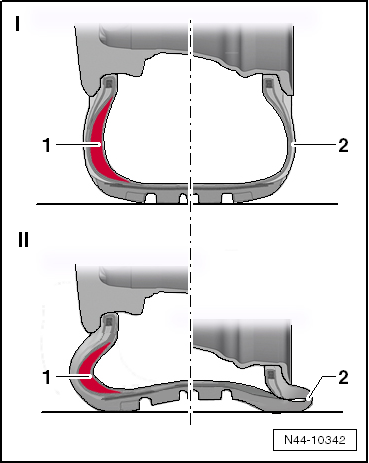Volkswagen Polo Service & Repair Manual: Run-Flat Tire, General Information
| Run-flat tires have a reinforced sidewall in comparison to
standard tires. This reduces the tendency for the sidewall to
roll when there is a loss of pressure and prevents the sides of
the tire from being pinched. This allows the vehicle to be
driven while still maintaining close to normal driving behavior.
It also eliminates the need to install the spare tire in
dangerous situations such as on the highway or in poor weather
conditions. |
| When there is a flat tire, the vehicle can still be driven
to the nearest workshop (within approximately 50 km) as long as
the vehicle speed (maximum 80 km/h (49.7 mph)) and driving style
are adapted accordingly, see the Owner's Manual. |
| If there is a flat tire, the driver is ultimately
responsible for checking the affected tire and deciding if it is
possible to continue driving. |
|
|
|
| -I- Tires with Normal Pressure |
| 1 - |
Run-flat tires (reinforced sidewall
-red-) |
| -II- Tires without Air Pressure |
| If the standard tire -2- loses
pressure, the rim pushes the side wall together. When the tire
is the flat, the sidewall becomes extremely hot from the rolling
motion and or is pinched. This destroys the tire. |
| In run-flat tires -1-, the
reinforced sidewall (-red-)
supports the tire. Because of a special rubber compound and the
reduced flexing of the reinforced sidewall, the tires does not
become as hot and the vehicle can still be steered. |
 Note Note
| Read and follow the special requirements for using run-flat
tires. Refer to
→ Chapter „Run-Flat Tire, Retrofitting/Conditions for use of
Run-Flat Tires“. |
|
|

|
Caution
Using run-flat tires on vehicles is permitted only
if the run-flat tire is supplied with the vehicle either
...
Other materials:
Introduction
This chapter contains information on the following subjects:
→ Socket in the vehicle
Electrical equipment can be connected to the socket in the vehicle.
The devices connected must be in good condition and fault-free.
Additional information and warnings:
Cigarette lighter
Acce ...
Introduction
This chapter contains information on the following subjects:
→ Warning lamp
→ Frontal collisions and the laws of physics
→ What happens to vehicle occupants who have not fastened their seat belts
→ Seat belt protection
→ Using seat belts
→ ...
Checklist
The following actions must always be carried out in the given
order in preparation for changing the wheel :
In the event of a flat tyre, park
your vehicle on a firm and level surface at a safe distance from the flow of
traffic.
Apply the handbrake firmly Braking,
stopping an ...
© 2016-2025 Copyright www.vwpolo.net

 Note
Note Run-Flat Tire, Retrofitting/Conditions for use of Run-Flat Tires
Run-Flat Tire, Retrofitting/Conditions for use of Run-Flat Tires

